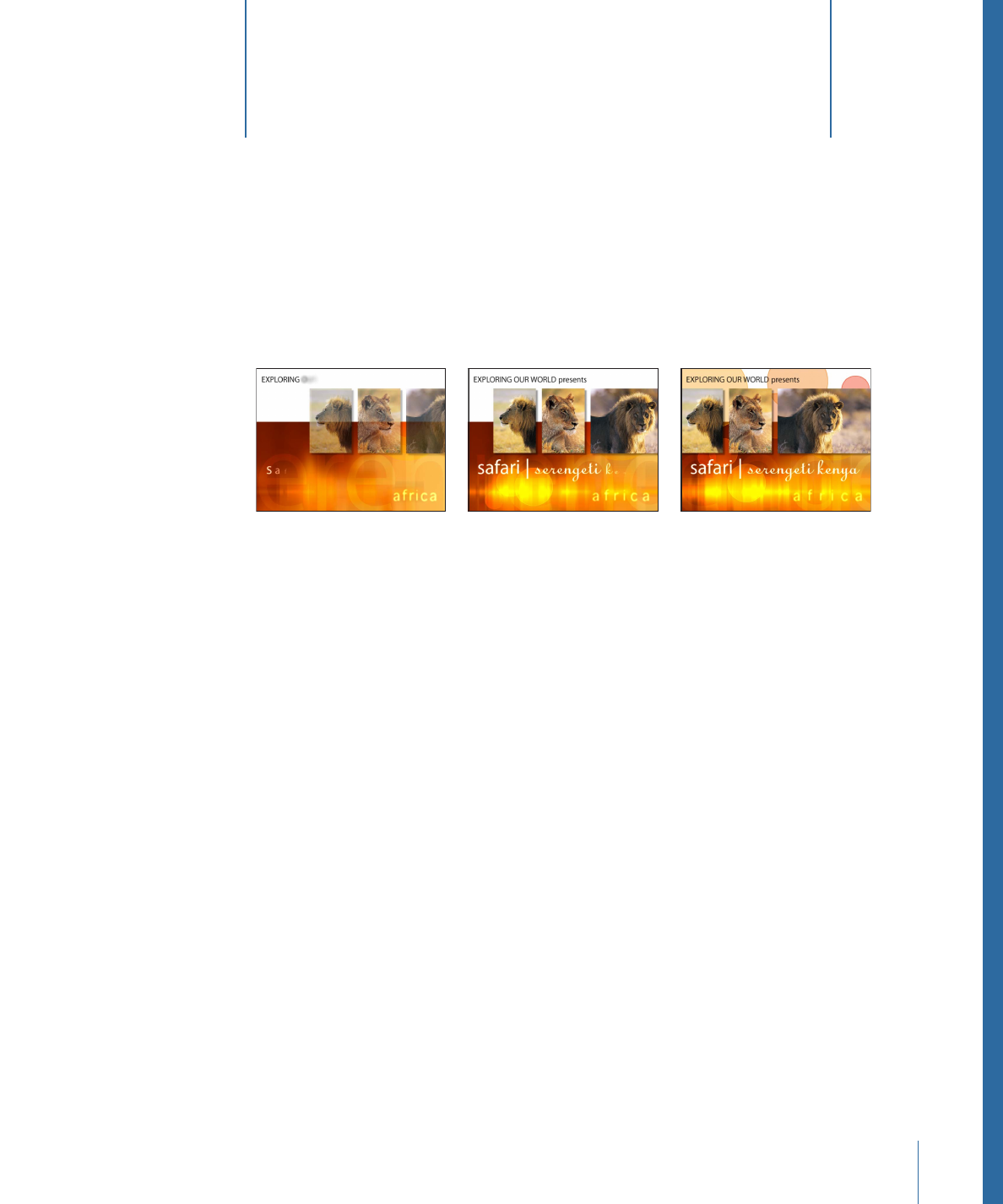
About Motion Projects
In Motion, you create 2D or 3D motion graphics and compositing projects with imported
images (such as Adobe Photoshop or Illustrator files), image sequences, QuickTime movies,
and audio files, as well as with objects created in Motion. These objects include text,
masks, shapes, particles, paint strokes, and so on.
A Motion project is made up of groups that contain layers. All media imported into Motion,
or elements created within a project (such as shapes or particles), are referred to as layers.
A layer must live in a group. The group acts as a “parent” to its layers. You can select
multiple layers in a group to create a nested group. A group can be 2D or 3D. For more
information on layer and group basics, see
Transforming Layers
.
Any item in Motion can be referred to as an object, but an item that you can see in the
Canvas, such as an image, shape, or text, is generally referred to as a layer. A camera,
light, rig, filter, behavior, and so on is generally referred to as an object.
Cameras and lights can be added to projects. When you add a camera to a project, you
can switch the project to 3D mode or to remain in 2D mode (unless the project is empty
or completely 2D, in which case it is switched to 3D mode). 2D groups can exist in a 3D
project. A 2D group can be nested in a 3D group. A 3D group can be nested in a 2D
group. When a 3D group is nested in a 2D group, the group is flattened. This means that
the nested 3D group acts like a flat card and ignores the camera. In addition, the flattened
group does not intersect with layers of the 2D group or other groups in the project. For
more information on working in 3D, see
3D Compositing
.
Any transforms, filters, or behaviors applied to a group are applied to all layers in the
group. If you move or apply a filter or behavior to a group, all layers in that group are
affected. You can also apply filters and behaviors to individual layers in a group.
A filter is a process that changes the appearance of an image. For example, a blur filter
takes an input image and outputs a blurred version of that image. For more information
on using filters, see
Using Filters
.
A behavior is a process that applies a value range to an object’s parameters, creating an
animation based on the affected parameters. For example, the Spin behavior rotates an
object over time at a rate that you specify. For more information on using behaviors, see
Using Behaviors
.
Groups and layers can be moved and animated by using behaviors or by setting keyframes.
For information about keyframing, see
Keyframes and Curves
. Filters can also be animated.
20
Chapter 1
About Motion and Motion Graphics

A project represents a single flow of image data built from the bottom up. In a composite
with a single group, the layers in that group are stacked above one another. Filters and
behaviors applied to a layer appear beneath the layer in the Layers list. The group
represents the image that results from its combined layers and their applied behaviors,
filters, and composite modes (blend modes). For more information on building projects,
see
Creating and Managing Projects
. For more information on basic compositing, see
Basic Compositing
.
In a simple example, a group contains a single image with applied color correction and
blur filters (in that order). The image provides the input data to the color correction filter.
The output data of the color correction is the input data for the blur filter. The group
represents the result of that image data flow. Groups and layers are also stacked one
above the other in a project—the output of the lower layer is the input to the layer above
it in the list.
When working in 3D mode, a layer that is below another layer in the Layers list can appear
above that layer in the Canvas if its Z (depth) position is closer to the camera. You can
force the layers to respect their order in the Layers list by selecting the Layer Order
checkbox in the Group pane of the Inspector.
21
Chapter 1
About Motion and Motion Graphics


This chapter introduces you to the Motion interface and describes how to use all the
basic tools you need to get started.
This chapter covers the following:
•
Project Browser
(p. 24)
•
Workspace Overview
(p. 25)
•
File Browser
(p. 26)
•
Library
(p. 32)
•
Inspector
(p. 41)
•
Toolbar
(p. 46)
•
Timing Display
(p. 53)
•
Canvas
(p. 55)
•
Viewing the Canvas or Timing Pane on a Second Display
(p. 80)
•
Project Pane
(p. 81)
•
Timing Pane
(p. 95)
•
HUD
(p. 118)
•
Text Field Shortcut Menu
(p. 121)
23